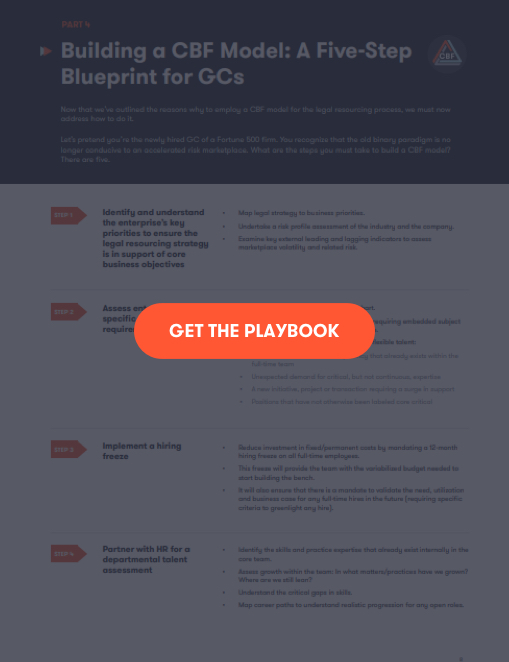When Do You Really Need the Expense of a Law Firm?
The answer is not during uncertain times, especially as another variant emerges.
This paper covers:
✔ Macro trends impacting the legal department today
✔ The deficiencies of the traditional model for legal resourcing
✔ The ideal model: Core-Bench-Firm (CBF)
✔ Building a CBF model: A five-step playbook for GC's
✔ Piloting, trialing, and improving
A New Model for Legal Resourcing: Core-Bench-Firm (CBF)
The ideal legal paradigm is a three-legged stool, consisting of a core, bench, and firm.
1. The Legal Department
- A lean full-time team of legal lieutenants is used to leverage internal enterprise knowledge, provide appropriate managerial scale and handle core competency work.
- Depending on the enterprise, the team is organized by region, division or practice area.
2. A Virtual Bench
- The core team is supported, almost entirely, by a bench of trusted, on-demand lawyers for expertise aligned to emerging risks, workload surges and law firm management.
- This bench/agile layer serves as a flexible extension of the in-house team.
- Critically, the bench is curated, built and onboarded before specific needs arise, according to subject matter expertise selected to address anticipated risks, thereby creating a standby team with existing institutional knowledge ready to ramp up at any time.
- This bench can be supplemented by additional lawyers, as work requires or as unexpected risks emerge.
3. The Law Firm
In this model the law firm has limited use-cases, which include:
- Litigation: Or more precisely, bet-the-company litigation matters.
- Enterprise benchmarking: To learn industry norms and emerging standards. These are issues where law firms have unique cross-industry/cross-enterprise expertise. For example, to identify general corporate policies on return to work, new labor and employment issues related to vaccine status, bigger issues specific to indemnification and insurance.
- Exceptional matters: Matters beyond the abilities of even the most robust internal legal department. This bucket includes complex M&A deal structuring and higher risk activities that require an army of legal minds.
- Issues that exceed the expertise or scale of the virtual bench: Herein lies the value of the agile layer. In the old paradigm, everything that can't be staffed internally gets sent out to law firms from the start. In this new model, expertise from the bench is tasked with handling the matter. That agile lawyer (or lawyers) can often handle the issue entirely - but that is not the only value he or she brings. Sometimes that lawyer can handle a matter through near completion, but then understands the needs and nuances requiring specific law firm expertise. That latter-stage and more finely tuned conversation with a law firm is far more informed, focused and valuable than it would have otherwise been from the start, which means lower costs and less managerial burden because the agile lawyer is participating in the law firm education process.
Download the Full Whitepaper & Playbook
* Required
